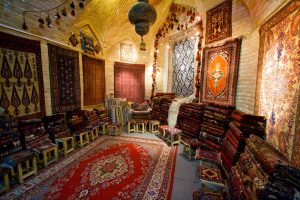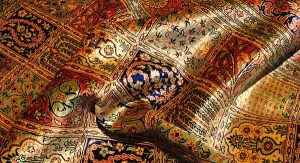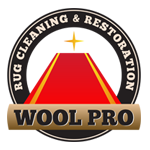Oriental Rug Appraisal
 Valuing antique rugs is a slippery slope. Since antique rugs vary so much in quality, and tastes are always changing in terms of decorating with antiques, which impacts demand, it’s almost impossible for the average individual to research the true value of an antique rug on their own.
Valuing antique rugs is a slippery slope. Since antique rugs vary so much in quality, and tastes are always changing in terms of decorating with antiques, which impacts demand, it’s almost impossible for the average individual to research the true value of an antique rug on their own.
Why get a rug appraisal?
There are a number of compelling reasons to have your Oriental or Persian rugs appraised. The most common reason for you to get an appraisal on your carpet is to safeguard your investment against damage or total loss by having it insured. In order for your rug to be protected, insurance companies will require an up-to-date appraisal of your rug.
Knowing who to trust for an accurate appraisal on your Oriental or Persian rug is important, and it’s equally important to know your appraiser has the background and credentials to back up their assessment. Having been a long-time member of the International Society of Appraisers, our antique Persian rug appraisal experts are guaranteed to provide you with a valuation you can have confidence in, whether you’re seeking an appraisal for insurance or to prepare your rug for sale.
Unrealistic Expectations
 Reputable rug dealers get calls every day from people with unrealistic expectations about what their gradmother’s antique rug is woth. They know she purchased the rug years ago, and think it’s worth a certain amount since they saw what seemed like a similar rug offered for sale at that price.
Reputable rug dealers get calls every day from people with unrealistic expectations about what their gradmother’s antique rug is woth. They know she purchased the rug years ago, and think it’s worth a certain amount since they saw what seemed like a similar rug offered for sale at that price.
But size, dyes used in manufactures, and design all play a part in dermining value, and similar- looking rugs may actually turn ou to be very different when examined closely.
Additionally, as with all antiques offered for sale, the selling price is often very different than a dealer’s asking price. This is why appraisers use comparable, actual selling prices, as often as possible when assessing values. If you don’t have access to information about whan an antique rug actually sold for, it is difficult to pinpoint a value even if you know the exact origine and age.
Furthermore, you really have to understand not only the makeup of the rug, but the current rug market in order to get to the bottom line value at any given time. This an instance in valuing antiques when it’s best to consult a professional.
In order to determine the value of an Oriental or Persian rug, the expert appraisers will examine a few key items:
Rug style and Area of Origination
By looking at your rug’s motifs, knotting style and colorings, the certified appraisers will establish where the rug was manufactured, as well as what type of rug you own. For example, a Persian rug made in the country of Iran featuring a Sarouk design.
Rug condition
An Oriental rug’s condition is directly linked to its value. However, certain antique rugs will often hold their value better than modern carpets, in spite of deterioration. During an appraisal, the experts assess everything related to your rug’s overall condition, inspecting it for damage or wear to the pile, selvedges, fringe, dyes and elsewhere.
Rug Size
Naturally, the size of your Oriental rug will play a role in its value, whether you are insuring the piece of planning to sell it. A gallery sized, oversized, room sized, runner or throw rug each have different values, but its size is always put into context with your rug’s other elements.
Rug age:
Your rug’s age can sometimes have an impact on its value, especially if the rug is considered an antique and in superb condition. Older Oriental rugs that exhibit a magnificent patina are particularly sought after in the marketplace, and are also more valuable when insured.
Rug color and Craftsmanship:
The quality of a rug’s craftsmanship is determined by the skill of the weaver who created it, including their technique, the excellence of their design and the number of knots-per-inch (KPI) in contains. The condition of your rug’s dyes also plays a tremendous role during an appraisal, such as whether the color are faded and stained or intensive and vibrant.
Having an Antique Rug Appraised
To have your antique rug appraised contact a reputable dealer, send them photos of your rug, and let them know the purpose of your appraisal:
– Are you looking to sell it, and want to know how much a dealer would pay for it? If the dealer is making an offer, it’s not really an appraisal but rather an offer to purvhase at the price set by the dealer.
– Are you interested in an auction house reserve price estimate? This is the least you would be willing to sell it for at auction – a safety net to protect your interests, so to speak.
– Do you want an assessment of what a fair market retail value would be? In other words, how much would a dealer expect to get for it if sold to a retail client.
– Are you wondering what a fair trade in value would be? In this case you’re likely looking for upgrade your rug to a better one or change the look of your room.
– Do you want to insure it, and require a fair market retail value appraisal? These appraisals will always be full written appraisals as required by insurance companies.
After you define the purpose, the appraiser will help you determine the type needed:
– Full written appraisal– These appraisals will usually cost a minimum of $500, if not more, depending on the dealer so be sure to ask about the free before having them look at your rug. A full written appraisal costs more since once it is signed and delivered it is considered to be an official document that may be used in court. It also takes considerable time to research comparable values and prepare the documentation. In addition, should be a legal situation arise relation to the value of the rug, the person who issued the appraisal might get called into court to testify. In addition to helping you find out what your rug might be worth should you decide to sell it or require a replacement due to fire or theft, having an appraisal helps to authenticate it and ultimately adds value to the carpet.
– Verbal estimation of value– These less formal estimates will usually cost around $100, unless you’re asking the dealer to make an offer on the rug. Dealers may do some research on sales of comparable pieces to help them determine values, but no written documentation is provided with a verbal estimation of value.
Note: It is generally accepted practice in the antiques marketplace that a dealer providing an appraisal should not also make an offer on an antique being appraised. Reputable dealers will either act as a buyer making an offer or an appraiser helping you determine value, not both.
The bottom line is that it may take a bit more effort than other types of antique valuations, but most folks find enlisting the help of an expert assists them greatly in obtaining the true value of their antique rugs.
You also should have your appraisal updated every 5-10 years depending on market trends.
Your investment carpet’s value can change significantly over time. Without an updated appraisal you may only be allowed the original purchase price for your rug should it become damaged. Without an updated appraisal it is possible that your antique rug could be under valued by your insurance company.
